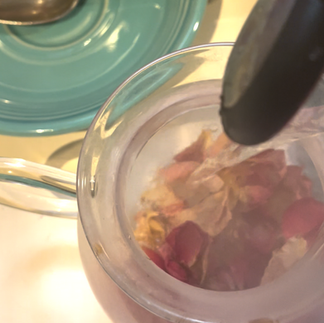May Day Vanilla Matcha Rose Latte
- janaejean
- May 1, 2022
- 4 min read
Updated: May 3, 2022
A Subtly Floral Beverage for the Midpoint of Spring

This weekend marks April 30 and May 1, a pair of days that together are celebrated in Celtic traditions as Beltane (sometimes spelled Bealtaine). Sometimes referred to as "spring's Halloween," Beltane marks the halfway point between the start of spring and the summer solstice (in the Northern hemisphere) as Halloween or Samhain marks the midway between the fall equinox and the winter solstice (in the Northern hemisphere). It is known as Walpurgis Night after Saint Walpurga (or Walburga, an Frankish (Germanic) abbess from the Middle Ages or The Night of Witches.
Additionally, May Day is another name for International Worker's Day (also known as "Labour Day" in many countries) A day that was initially meant to recognize the need for an eight-hour work day. The tragic Haymarket Affair took place at a May Day worker's meeting in Chicago on May 4, 1886 where workers were taking place in a work stoppage to protest for an eight-hour work day. A bomb was thrown by an unknown person as police attempted to disperse the workers and the ensuing madness left several people dead and many injured. Eight anarchists were arrested, four of them where executed, one committed suicide while in jail, and the others were pardoned by the Illinois governor. Richard Oglesby. May Day continues to be a day were activists raise awareness for labor rights and the historic struggles of the working classes.
While not a labor holiday per se, ancient May Day shares the 29th centuries focus on the working people rather than the aristocracy. The traditional spring festival version of May Day is a holiday with agricultural, as well as fertility festival, roots. Some of the most ancient celebrations go back to the Ancient Romans who celebrated a six-day long feast in honor of the goddess of flowers, Flora, from April 28 to May 3. The festivities included theatrical performances, music and dancing, competitive game, and sacrifices to the goddess. Flowers, especially vetches and lupins, and beans were gathered and displayed as fertility symbols. Hares and goats—both considered symbolically salacious—were released. And, people would wear lavish clothes. In 69, Floralia was topped off by a tightrope-walking elephant!
In the Celtic world, the May Day festival was called "Beltane" in honor of the fire god. The world "Beltane" comes from the the god's name, Bel and means "Bel's day" or "day of fire." Gaelic peoples would light large bonfires and dance at night as part of the festivities. Historically, it was observed in not just by the Gaelic peoples of Ireland, Scotland, and the Isle of Mann. The festival recognized the longer daylight and approaching summer. Yellow and white flowers were specifically chosen to adorn homes to evoke the brightness of fire and the sun.
While "Beltane" has specifically Celtic origins, other ancient European Pagans celebrated on April 30 and May 1 as well. To celebrate the sowing of the fields and the return of the livestock to the pastures, people in medieval Europe sang, danced, and decorated themselves and their livestock with spring flowers. Young people would dance with ribbons maypole, resplendent with fresh blooms, similar to those found at Scandinavian midsummer festivals.
In Germany, May Day celebrations became associated with the late eighth century abbess Saint Walburga (or Walpurga) who is credited with converting the Saxons. It is said that Walburga could battle “pest, rabies and whooping cough” and the grocery of witches. Therefore, superstitious medieval Christians would flock to the Walburga (and later her relics) for protection from supposed evil witches.Today in Germany, the holiday is celebrated similarly to Halloween in the United States with costumes, parades, and playing pranks. There is also feasts complete with German Beer and folk music and lover's will jump over a leap together to assure long love.
So let's all take a few moments to enjoy the blooms of spring with a May Day Vanilla Matcha Rose Latte.

May Day Vanilla Matcha Rose Latte
Makes 2 servings
12 ounces just under boiling water
¼ cup dried rose petals
1 to 3 teaspoons of ceremonial-grade matcha powder
1/16 to 1/8 teaspoon of pure vanilla extract
1 to 3 teaspoons raw cane sugar
4 teaspoons half and half or oat milk
Whipped cream or whipped coconut topping (if desired)
Dried rose buds for garnish (if desired)
Place rose petals in small teapot.
Pour hot water over rose petals.
Let steep for 10 minutes.
Measure match powder.
Add matcha to bowl for whisking.
Strain rose water through tea strainer into matcha bowl.
Whisk matcha in "M" direction.
Measure out a small amount of vanilla.
Add vanilla to match and stir.
Measure desired amount of sugar for each serving.
Add sugar to each cup if desired.
Measure desired amount of half and half or oat milk for each serving.
Add half and half or oat milk to each cup if desired.
Give it a final stir before serving.
Garnish with whipped topping and rosebud, if desired.
Recipe Video
Happy May Day!
For more on May Day
What Is May Day?
Germany's Night of the Witches
May Day – International Worker's Day History
Irish Beltane Origins
What Is May Day History?
Roman Floralia
Who Was St. Walburga?

Janae J. Almen is a professional music instructor, composer/sound artist, and published writer for both in-print and online media. She is the founder of Perennial Music and Arts and is passionate about sharing her love of music and arts as well as tea, coffee, baking, cooking, and culture.
All photos and music ©2022 Janae J. Almen

































Comments